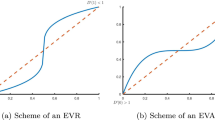Abstract
Recently Rao et al. [13] established the strong consistency and asymptotic normality of the maximum likelihood estimates of the 2-D superimposed exponential signal model under the assumption of normality of the error random variables. In this paper we investigate the theoretical properties of the least squares estimates of the same model under the assumption of general error distribution. The strong consistency and asymptotic distribution of the least squares estimates have been obtained. Further extension to the multidimensional case has been proposed.
Similar content being viewed by others
References
M. M. Barbieri and P. Barone, “A Two Dimensional Prony's Method for Spectral Estimation,”IEEE Trans. Signal Processing, vol. 40, no. 11, 1992, pp. 2747–2756.
S. D. Cabrera and N. K. Bose, “Prony Methods for Two Dimensional Complex Exponential Signals Modeling,”Applied Control (Spyros G. Tzafestas, Ed.), Chap. 15, New York: Dekker, 1993, pp. 401–411.
J. Chun and N. K. Bose, “Parameter Estimation Via Signal Selectivity of Signal Subspace (PESS) and its Application to 2-D Wavenumber Estimation,”Digital Signal Processing vol. 5, 1995, pp. 58–76.
K. L. Chung,A Course in Probability Theory, London: Academic Press INC, 1974.
D. E. Dudgeon and R. M. Merseresau,Multidimensional Digital Signal Processing, Englewood Cliffs, NJ: Prentice-Hall, 1984.
Y. Hua, “Estimating Two-Dimensional Frequencies by Matrix Enhancement and Matrix Pencil,”IEEE Trans. Signal Processing, vol. 40, no. 9, Sept. 1992, pp. 2267–2280.
S. Kay,Modern Spectral Estimation: Theory and Application. Englewood Cliffs, NJ: Prentice-Hall, 1980.
S. Kay and R. Nekovei, “An Efficient Two-Dimensional Frequency Estimator,”IEEE Trans. Acoust., Speech, Signal Processing, vol. 38, no. 10, 1990, pp. 1807–1809.
D. Kundu, “Asymptotic Theory of Least Squares Estimator of a Particular Non-linear Regression Model,”Statistics and Probability Letters, vol. 18, 1993, pp. 13–17.
S. W. Lang and J. H. McClellan, “The Extension of Pisarenko Method to Multiple Dimensions,” inProc. ICASSP-82 (Paris, France, May 1982) pp. 125–128.
V. Mangulis,Handbook of Series for Scientists and Engineers, New York and London: Academic Press, 1965.
J. McClellan, “Multidimensional Spectral Estimation,”Proc. IEEE, vol. 70, no. 9, 1982, pp. 1029–1039.
C. R. Rao, L. Zhao and B. Zhou, “Maximum Likelihood Estimation of 2-D Superimposed Exponential Signals,”IEEE Trans. Acoust., Speech, Signal Processing, vol. 42, no. 7, 1994.
A. M. Walker, “On the Estimation of a Harmonic Component in a Time Series with Stationary Independent Residuals,”Biometrika, vol. 58, 1971, pp. 21–36.
C. F. J. Wu, “Asymptotic Theory of Non-linear Least Squares Estimation,”Annals of Statistics, vol. 9, 1981, pp. 510–513.
Author information
Authors and Affiliations
Additional information
The work is partly supported by a Grant (No: SR/OY/M-06/93) of the Department of Science and Technology, Government of India
The work is partly supported by the National Board of Higher Mathematics, Department of Atomic Energy, Government of India
Rights and permissions
About this article
Cite this article
Kundu, D., Mitra, A. Asymptotic properties of the least squares estimates of 2-D exponential signals. Multidim Syst Sign Process 7, 135–150 (1996). https://doi.org/10.1007/BF01827810
Received:
Revised:
Issue Date:
DOI: https://doi.org/10.1007/BF01827810




